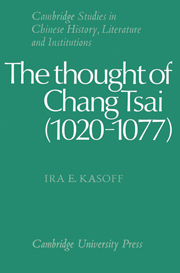Summary
Introduction
In this chapter I will discuss Chang Tsai's view of heaven-and-earth by examining four concepts fundamental to that view: ch'i, yin–yang, t'ien and shen. Through his theories about heaven-and-earth, Chang was able to address two of the issues that concerned many eleventh-century literati: how to refute Buddhist theories, and how to ‘string it all on one thread.’ And like some of his contemporaries, Chang developed his cosmology from the Book of Change. More specifically, he based it on certain passages from the Hsi tz'u chuan and on his view of the significance of the hexagrams themselves. Chang felt that the hexagrams not only symbolized, but actually embodied, the forces governing heaven-and-earth, and that this was all explained in the Hsi tz'u chuan. explained in the Hsi tz'u chuan.
As noted above, Ch'eng Hao wrote that Buddhist ideas were ‘close to principle.’ Chang expressed a similar sentiment:
The words [of the Buddhists]… resemble the correct [Way].
In other words, Buddhist theories are persuasive; so persuasive that Chang is reputed to have spent ten years studying them. However, Chang left Buddhism, having decided that its doctrines were wrong. The above passage continues:
But when we examine their point of origin and their key points, [we see that] the origin and the key points are different from those of our Confucian [Way]. There is only one Way. If this is correct, that is incorrect; if that is correct, I am incorrect. (183.4)
This passage reveals both of the central themes in Chang's view of heaven-and-earth: his rejection of Buddhism, and his belief in the ‘one thread.’
- Type
- Chapter
- Information
- The Thought of Chang Tsai (1020–1077) , pp. 34 - 65Publisher: Cambridge University PressPrint publication year: 1984



